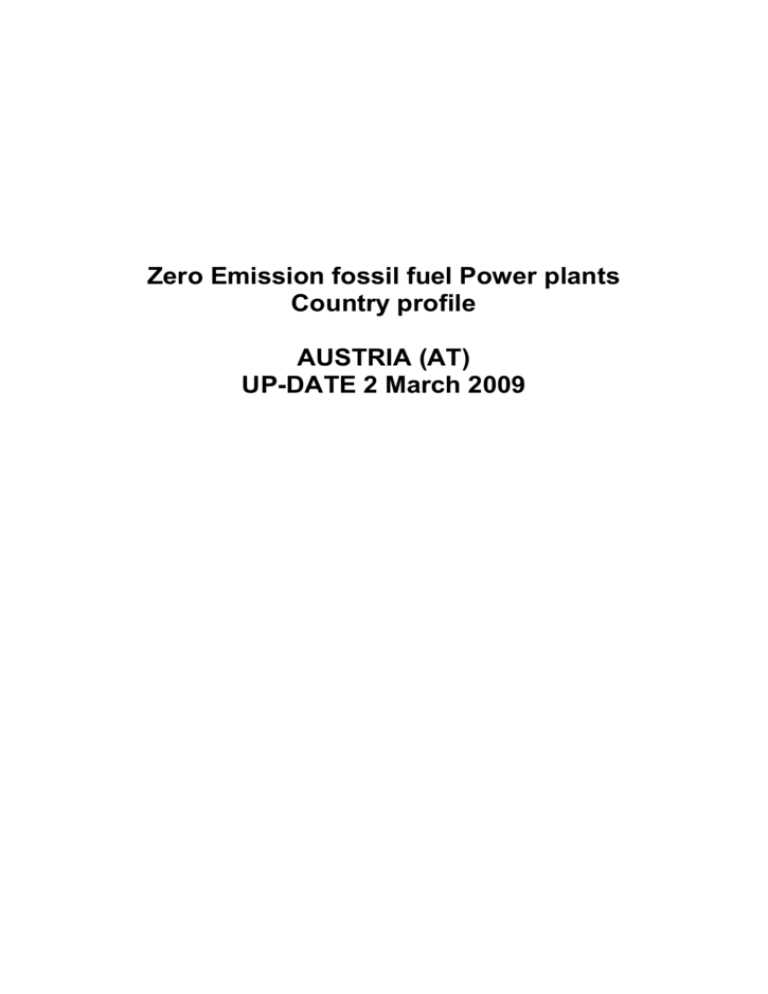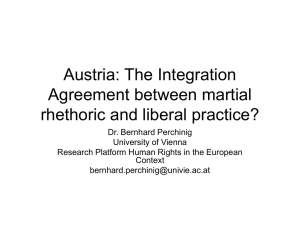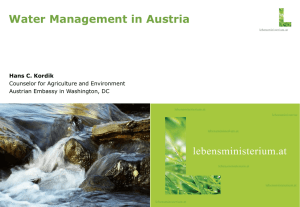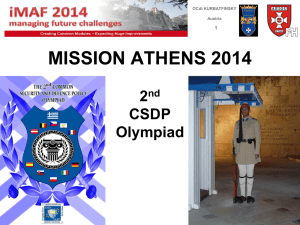Zero emission fossil fuel power plants
advertisement

Zero Emission fossil fuel Power plants Country profile AUSTRIA (AT) UP-DATE 2 March 2009 Introduction This document contains a short summary of the national current situation with respect to Zero Emission Fossil Fuel Power Plants. It aims to support the taskforces of ETP-ZEP. We have used the information already available, in particular - National Allocation Plan for Austria 2005-2007 pursuant to Art. 11 of the EZG 31 March 2004 (with additions dated 7 April 2004) Federal Ministry of Agriculture, Forestry, Environment and Water Management (http://gpool.lfrz.at/gpoolexport/media/file/NAP_Austria_en.pdf); NAP2 20082012 (http://umwelt.lebensministerium.at/filemanager/download/19342/ ) - Anpassung der Klimastrategie Österreichs zur Erreichung des Kyoto-Ziels 2008-2013 (Version 21 March 2007) Federal Ministry of Agriculture, Forestry, Environment and Water Management (http://www.klimastrategie.at/article/articleview/55600/1/8790) - The FENCO-ERA.NET questionnaire and database Further information sources used for this profile are: - documents: o Survey: “Wasserstoff und Zero Emission Power Plants: Erhebung im Technologiebereich Zero Emission Power Plants, CO2-Abtrennung und -Speicherung” (Austrian Energy Agency on behalf of Federal Ministry of Economics and Labour and Federal Ministry of Transport, Innovation and Technology) o Paper of SPE International (Society of Petroleum Engineers): CO2 –Sequestration Potential in Austrian Oil and Gas Fields, Claudia Scharf, University of Leoben, Torsten Clemens, OMV Chapters 1-5 contain facts and observations, no opinions. Chapter 6 (lessons for ZEP) contains opinions. ZEP Country Profile AT update May 2008 2 1 Background information 1.1 CO2 emissions: present and future The National Allocation Plan for Austria1 describes the goal of reducing the emissions of the greenhouse gases in accordance with Council Decision 2002/358/EC. According to the latest greenhouse gas emissions inventory of the Federal Environment Agency, Austria emitted 78.96 million tons CO 2-equivalents in the Kyoto base year 1990. This value covers all greenhouse gases within the scope of the Kyoto Protocol. For Austria, the 13% reduction of greenhouse gases in the Kyoto commitment period 2008-2012 translates into a target value of about 68.69 million tons CO2-equivalents. Compared to the 1990 figures, this is a reduction by 10.27 million tons CO2-equivalent. The present trend of greenhouse gas emissions presented by the „Klimastrategie“ 2 shows for Austria in 2005 a total greenhouse gas emission of 93.2 million tonnes CO 2 equivalents; this is an increase of 18% compared to the baseline year 1990. In absolute numbers the emissions in 2005 were 14.2 million tonnes CO 2 equivalents higher than 1990 and approximately 24.4 million tonnes CO 2 equivalents over the agreed Kyoto target of 68.8 million tonnes CO2 equivalents. With the use of the flexible mechanism of the Kyoto Protocol (JI/CDM programs) an amount of 9 million tonnes CO2 equivalents are achieved and the rest of approximately 1.4 million tonnes CO2 equivalents have to be attained within 2008-2012. It is not to conceal that for Austria a notable effort is necessary to meet the reduction target and decrease greenhouse gas emissions. One possibility to decrease the emissions is the geological storage of these gases. Austria is an industrial country with a long history of oil and gas production. The basins from which hydrocarbons are produced are not so far from industry sites. Hence geological storage of CO 2 generated by industrial processes could be economically attractive. 1.2 Energy production: energy mix - present The energy consumption in Austria in 2006 was around 1442.2 PJ and 89% (1284.8 PJ) had to be covered by energy imports. As the lower part of table 1 illustrates, the Austrian industry and transport sectors are responsible for half of the energy consumption. 1 National Allocation Plan for Austria 2005-2007 - pursuant to Art. 11 of the EZG 31 March 2004 (with additions dated 7 April 2004) Federal Ministry of Agriculture, Forestry, Environment and Water Management (http://gpool.lfrz.at/gpoolexport/media/file/NAP_Austria_en.pdf) 2 Anpassung der Klimastrategie Österreichs zur Erreichung des Kyoto-Ziels 2008-2013 Vorlage zur Annahme im Ministerrat am 21. März 2007 Bundesministerium für Land- und Forstwirtschaft, Umwelt und Wasserwirtschaft (http://www.klimastrategie.at/article/articleview/55600/1/8790 ZEP Country Profile AT update May 2008 3 Petajoule [PJ]3 Energy production and consumption (overview) Domestic energy production Import Total quantity: domestic energy production+import Storage Export Total consumption: Domestic energy production+import+storage-export Industry Transport Services Private housholds Agriculture Final consumption (losses considered) 2004 422.6 1170.6 2005 408.2 1238.3 2006 420.7 1284.8 1593.2 1646.5 1705.5 -15.8 189.7 -7.7 205.0 -25.1 238.1 1387.7 1433.8 1442.2 304.0 329.8 135.2 269.3 24.7 309.8 343.8 134.4 284.8 25.0 318.5 336.7 137.1 276.1 24.3 1063.1 1097.9 1092.8 Table 1: Overview of Austrian Energy production and consumption Domestic energy production in Petajoule [PJ] Coal 1970 1975 1980 1985 1990 1995 1996 1997 1998 1999 2000 2001 2002 2003 2004 2005 2006 PJ 54 43.5 35.2 38.8 26.7 14.2 11.0 11.2 11.3 11.1 12.3 11.8 13.9 11.3 2.3 0.0 0.0 Oil % 14.7 12.4 10.6 11.3 7.8 3.8 3.0 3.0 3.0 2.7 3.0 2.9 3.3 2.6 0.6 0.0 0.0 PJ 119.2 87.4 63.7 49.3 50.6 45.8 44.4 43.7 44.5 45.3 45.7 43.0 37.7 51.4 45.1 41.1 42.1 Gas % 32.6 24.9 19.1 14.4 14.8 12.4 12.2 11.8 11.9 11.1 11.1 10.4 9.0 11.7 10.7 10.0 10.0 PJ 69.5 87.6 70.6 42.2 46.4 53.3 53.7 51.4 56.4 62.5 64.8 62.2 67.5 75.1 70.5 59.3 66.1 % 19 24.9 21.2 12.3 13.6 14.4 14.7 13.9 15.0 15.3 15.8 15.0 16.2 17.2 16.7 14.4 15.7 Hydropower PJ 76.6 85.7 104.8 111.4 113.4 133.4 123.2 130.0 133.8 145.8 150.6 144.7 143.8 130.8 131.1 129.1 125.6 % 20.9 24.4 31.4 32.4 33.2 36.1 33.7 35.1 35.6 35.6 36.7 35.0 34.5 29.9 31.0 31.3 29.8 Other Renewables PJ % 46.9 12.8 47.3 13.5 59.1 17.7 101.6 29.6 104.2 30.5 122.4 33.2 132.7 36.4 134.6 36.3 129.5 34.5 144.9 35.4 137.1 33.4 151.7 36.7 154.3 37.0 169.1 38.6 174.0 41.1 182.7 44.3 186.8 44.4 Total PJ 366.2 351.5 333.4 343.4 341.3 369.1 365.0 370.8 375.5 409.7 410.5 413.4 417.2 437.7 423.1 412.3 420.7 Table 2: Austrians energy production from 1970 to 2006; breakdown by fuel type 3 1 PJ [Petajoule] = 277.8 GWh [Gigawatt hours] ZEP Country Profile AT update May 2008 4 % 100 100 100 100 100 100 100 100 100 100 100 100 100 100 100 100 100 The Austrian domestic energy production from 1970 to 2006 is shown in the Table 2. A steady increase of the renewable energy sources and a steady decrease of coal as an energy source can be observed. Also hydropower generation shows a remarkable growth in the display period. Table 3 shows the Austrian electricity generation in the period from 1999 to 2006 by fuel type. For nearly all kind of power plants in the last reference year 2006 a slight decrease of electricity production is observable. Gross electricity generation in GWh River power plants 1999 2000 2001 2002 2003 2004 2005 2006 29,593 31,115 29,501 30,091 24,649 26,681 26,275 25,706 Storage power plants 10,900 10,724 10,686 9,840 11,695 9,742 9,599 9,172 Hydro power plants (total) 40,493 41,839 40,187 39,931 36,344 36,423 35,875 34,878 Hard coal 2,774 4,305 5,002 5,109 6,903 6,891 6,058 6,368 Lignite 1,497 1,292 1,549 1,460 1,512 999 Fuel oil 1,820 1,162 1,244 1,302 1,542 1,516 1,466 1,540 Natural gas 7,428 6,717 7,322 8,618 10,653 10,124 12,153 10,233 Other energy 1,257 1,347 1,388 1,467 1,625 1,955 2,281 2,724 Thermal power plants 1,096 651 14,776 14,823 16,505 17,956 22,235 21,485 23,054 21,516 Table 3: Austrian gross electricity generation by kind of production 1.3 Storage: possibilities with respect to underground storage4 To evaluate the potential of CO2 storage in Austria first, the maximum storage was estimated based on expected total hydrocarbon production. Next, the eleven largest oil and thirteen largest gas fields in Austria were investigated in more detail. The storage capacity of these fields5 was determined as 465 Mio t CO2, 430 Mio t CO2 could be stored in fields located in the Vienna Basin and 35 Mio t CO2 in the Molasse Basin between Linz and Salzburg. All of the fields evaluated except Aderklaa are still producing. The time, in which they could be converted for CO 2 storage has to be determined concisely, taking also the economics of current oil and gas production into consideration. A realistic point in time might be between 2010 and 2025. Excerpt from SPE International (Society of Petroleum Engineers) paper: CO2 –Sequestration Potential in Austrian Oil and Gas Fields, Claudia Scharf, University of Leoben, Torsten Clemens, OMV 5 OMV: Schönkirchen Tief, Höflein, Schönkirchen Übertief, Reyersdorfer Dolomite, Aderklaa RAG: Atzbach Schwanenstadt and Voitsdorf 4 ZEP Country Profile AT update May 2008 5 1.4 Energy-related industry (names, not statistics)6 1.4.1 Main utilities: EVN AG Verbund Austria Thermal Power GmbH & Co KG Wienstrom GmbH Energie AG Oberösterreich Linz Strom 1.4.2 Main oil, gas industries: OMV Austria Exploration & Production GmbH RAG Rohöl-Aufsuchungs AG 1.4.3 Main energy-intensive industry: 1.5 2 Voestalpine Stahl Linz GmbH Böhler Edelstahl GmbH & Co KG Wopfinger Baustoffindustrie GmbH Sappi Austria Produktions GmbH & Co KG (paper industry) Government: main ministries that deal with CCS: Federal Ministry of Economics and Labour (www.bmwa.gv.at) Federal Ministry of Agriculture, Forestry, Environment and Water Management (www.lebensministerium.at) Federal Ministry of Transport, Innovation and Technology (www.bmvit.gv.at) R&D On behalf of the Federal Ministry of Economics and Labour and the Federal Ministry of Transport, Innovation and Technology a survey was carried out by the Austrian Energy Agency7 to identify the Austrian key players and R&D activities within CCS. An increased interest in CCS issues could be noted and 13 organizations (five 6 Selection based on annual CO2 emission quantities. Source: National Allocation Plan for Austria 2005-2007 - pursuant to Art. 11 of the EZG 31 March 2004 (with additions dated 7 April 2004) Federal Ministry of Agriculture, Forestry, Environment and Water Management (http://gpool.lfrz.at/gpoolexport/media/file/NAP_Austria_en.pdf) 7 Survey: “Wasserstoff und Zero Emission Power Plants: Erhebung im Technologiebereich Zero Emission Power Plants, CO2-Abtrennung und -Speicherung” (Austrian Energy Agency on behalf of Federal Ministry of Economics and Labour and Federal Ministry of Transport, Innovation and Technology) ZEP Country Profile AT update May 2008 6 industry partners, two SME and seven universities) with current activities were evaluated. The company Austrian Energy & Environment, a supplier of thermal power generation and environmental engineering, focuses on post combustion technology and oxy-fuel firing technology. The main topics of research of the identified universities are in the area of Oxy Combustion, Chemical Looping Combustion and in the execution of feasibility studies. Partners in projects related to CO2 storage were OMV (e.g. EOR project Weyburn) and RAG (European Framework project CASTOR). In June 2006, OMV established the “OMV Future Energy Fund” to initiate the change from an oil and gas enterprise to an energy enterprise with renewable energy and CCS activities in its portfolio: In the fund 100 million € for the duration of 10 years are allocated. In summary the interview partners mentioned the following „critical issues“ for the implementation of CCS: 3 Ownership of and liability for stored CO2 Requirements for the CO2 storage places, purity of the CO2 to be stored and storage behavior of CO2 Need for common legal framework Intellectual property rights Monitoring and verification of CO2 beds Risk assessment Amendment of the economical frameworks (e.g. existing mechanisms such as the EU Emissions Trading Scheme (EU ETS) and Clean Development Mechanism (CDM)) Implementation With the Austrian Fenco Initiative8 (AFI) and the Austrian Fossil Fuel Fund, the national plant building industry and electricity producers have created an appropriate platform. The aim of this initiative is to prepare a new research concept. As a registered association, the AFI task force is carried by the utilities EVN, Energie AG, Linz Strom, Verbund-ATP, Wienstrom and the Austrian Association of Electricity Companies (VEÖ), as well as the suppliers Alstom and Siemens. Research activities are financed by the Austrian Fossil Fuel Fund (AFFF), a research and development fund that has been earmarked for plants fired with low-emission fossil fuels. With this fund, Austria has formed the national sponsoring reserve required for participation in ERANET projects. Within the scope of FENCO-ERA, the AFI has received the initial assignment of preparing and communicating the role of zero emission fossil fuels in 8 http://www.responsibility.evn.at/pdf/NHB_04_05_englisch.pdf ZEP Country Profile AT update May 2008 7 the energy supply of the enlarged EU, as well as their importance to security of supply and price, added value and environmental protection. 4 Public acceptance One explicit aim of the AFI initiative is the funding of studies on relevant social and legal questions. 4.1 First Study The first study funded by AFFF was titled: “Enquiry of the actual situation and identification of the "NON TECHNICAL BARRIERS" for the application of fossil fuels also with high technology as well as the determination of improvement, economical effects and social barriers”9 This study was carried out by three different organizations: The company Allplan concentrated on a technical overview of existing technologies and studies of public attitudes in regard to CCS. The Umweltbundesamt (UBA: expert authority of the federal government in Austria for environmental protection and environmental control) presented an analysis “Erhebung der umweltrechtlichen Bestimmungen und nicht technischen Barrieren für fossile Energieträger für ausgewählte Technologien aus Umweltsicht“ of the relevant rules and guidelines necessary for the implementation of fossil fuel power plants with CCS. The Industriewissenschaftliches Institut (IWI) covered in a case study the direct and indirect economical aspects of building and operating of a coal-steam power plant with 700°C steam temperature and CCS technology 4.2 Second Study End energy scenario 2050 - A project of the Austrian Fenco initiative. The End energy requirement in Austria will be 30% less than today in 40 years and will come – based on optimistic assumption – from renewable energy sources. That is the central result of a questioning broadly put on of 225 experts from industy, environment NGOs, science and administration in the context of stakeholder dialogs and workshops. Basic project results: • The end energy consumption in the year 2050 will be 668 Petajoule compared with 1004 Petajoule in 2005 • Doubling of the portion of renewable energies in the total energy-mix, decrease of oil consumtion around about 66 per cent, decrease of gas consumption around about 50 per cent, 9 text in German only ZEP Country Profile AT update May 2008 8 • Increase of electricity from renewable energies in the year 2050 compared with 2008: Solar electricity: + 8 TWh, wind and water power: in each case + 5 TWh, biomass: + 1 TWh • Largest savings of end energy in the sector „heating, warm water and air conditioning “(53 per cent), followed by the sector „mobility “around 40 per cent - Reasons for reductions: Range heating ets.: Substantial retrofits and redevelopments of thermal and house-techniques , almost new buildings as passive households, but: doubling energy needs for air conditioning Range mobility: Decrease consumption in the cargo transports (minus 15%) and in passenger car traffic (minus about 66%) but: Increase in the air traffic around 30 per cent and in public traffic around almost 80 per cent • Small reduced consumption in special goods production (only about 6 per cent) • Decrease of electricity production from fossil fuels • Energy-mix referring end user energy by electricity production and district heating in the year 2050 almost constantly comparing 2008 • The electricity consumption for lighting, telecommunication and electrical-devices decrease until 2050 altogether to a third of the value of 2005. The „Stakeholder dialogue “: • Discussions of 30 energy experts during four all day workshops (January, March, April and June 2008) • Questioning of further 567 experts in the period of May/June 2008 • In total 225 experts delivered their future scenario, their estimations with the questioning. The process organization was done by the consulting company “denkstatt”, for the technical expert's assessment the responsibility was at the company “ÖGUT Austrian society for environment and technology” The instructing party was the Austrian Fenco Initiative (AFI). AFI is a research promotion funds for topics regarding fossil fuels and held by members; which core competencies is in the range of fossil fuel power stations. A goal of the AFI is the promotion of fossil fuels in Austria and Europe. By the view of AFI the use of fossil fuels in the energy power supply of Austria is a huge importance to provide a energy security for the country. ZEP Country Profile AT update May 2008 9








